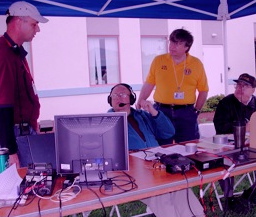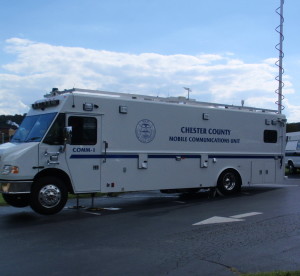County’s Amateur Radio Field Day exercises, equipment on view this weekend
By Kathleen Brady Shea, Managing Editor, The Times

Members of the Chester County Amateur Radio Emergency Service/Radio Amateur Civil Emergency Service (ARES/RACES) will participate in the 80th Annual Radio Field Service Day, a 24-hour exercise that begins Saturday at 2 p.m. and is open to the public.
Waves of amateur radio operators throughout Pennsylvania will conduct an annual exercise this weekend to determine the limits of their emergency communications capability, the county’s Department of Emergency Services said.
Thousands are expected to participate in the 80th annual Amateur Radio Field Day, a national 24-hour event that begins at 2 p.m. Saturday and ends at 2 p.m. on Sunday, a county news release said. Locally, the participants will be members of the Chester County Amateur Radio Emergency Service/Radio Amateur Civil Emergency Service (ARES/RACES), a group that supports the county’s emergency services to back up and supplement communications in an emergency, the release said.
“They are a very important backup for us,” said Patty Mains, a spokesman for the county’s Department of Emergency Services. “If our radio system goes down, they are able to fill in.” Mains said she could remember two instances in the past couple of years during which the amateurs provided vital communication during a phone outage.

Chester County’s COMM-1 vehicle will be on display at the Government Services Center this weekend for the 80th Annual Amateur Radio Field Day exercise.
“Their radio system seems to work all the time,” she said, adding that the purpose of Saturday’s exercise is to ensure that the equipment is functioning properly. She said the amateurs will be set up in the parking lot of the government services building, and the public is welcome to stop in and observe.
“What they will see first is a gaggle of antennas extending across the parking lot,” said Lloyd Roach, the public information officer for ARES/RACES. He said the group would do demonstrations of some of its emergency equipment for visitors. A portable “visitor-friendly” Get On the Air (GOTA)_will be installed for public inspection and participation. In addition, the county’s sophisticated communications vehicle, COMM-1, will be on display, wheels that cost “about 10 times more than my house,” Roach suggested.
Roach said the exercise began in 1933 by the American Radio Relay League to practice preparedness and is now conducted annually throughout the U.S. and Canada. One requirement of the 24-hour drill is that the radio hams have to rely on emergency power, Roach said.
He said over 25 volunteers will operate in voice, single side band, FM, digital data modes and Morse Code, communicating with as many other Field Day stations as possible. Several high-frequency HF, VHG, and UHF bands will be used to maximize radio propagation throughout the exercise, he said.






My wife worked for the American Red Cross. During the Vietnam War. The only way to reach US military feild officers in Vietnam by phone from the United States was by way of ham radio. Betsy spoke to several field officers concerning granting leave because of an emergency in a soldier’s family by way of ham radio.